Think comics are just for laughs? Think again. ‘Just Comics’ uses deceptively simple illustrations to confront pollution, factory farming, and environmental neglect, turning heavy topics into powerful, bite-sized wake-up calls.
Every panel hits like a quick gut check: a stray plastic straw becomes a choking sea creature, a factory farm shifts the balance of compassion. The artist doesn’t yell; they simply draw, translating pain into art with restraint that demands attention and empathy.
Scroll down, take it in, and maybe let it inspire you to act. These aren’t just sketches; they’re calls to care.
More info: Instagram | patreon.com
#1
I drew this story based on footage from a farm supplying Lidl, recorded by whistleblower Tom Herok, a philosophy teacher at the University of Lancaster. He worked in the UK chicken industry for months last year. ”What I saw was horrendous,“ ”From the start, the chickens are treated like trash. They‘re selectively bred to grow as fast as possible…and so their lives are horrible.“ Their bones and organs struggle to cope with the unnaturally rapid growth. [1]
The last slide is a screenshot from the videos, shows what a worker tells Tom Herok on a hidden camera.
Imagine seeing a small chick on the ground, struggling to walk. He moves a few steps with difficulty, then sits down to rest because his legs hurt, and then struggles to walk again. Part of your job is to kill them, as the farm prefers they don’t grow up. They are not worth the feed, as they cannot grow as quickly as desired.
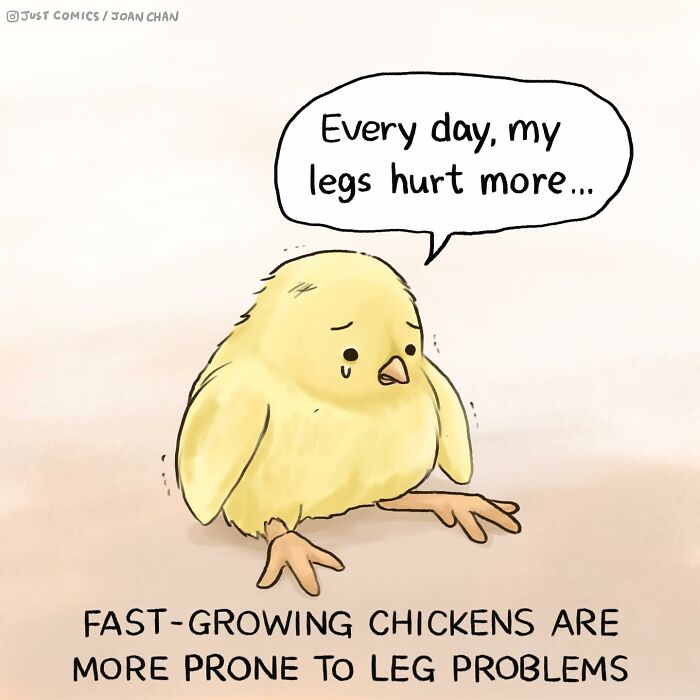
Image source: justcomics_official
#2
This recent study changed my thought about insects. We all know that bees are intelligent and sensitive, but… they can also play?
A study conducted by researchers at the Queen Mary University of London suggests that bumblebees play. They enjoy rolling wooden balls around, without any external reward or encouragement.
In the study, the bumblebees live in their nest with a tunnel going to an area with food, but with a choice to divert to a special area with the balls. All bees rolled the ball at least once, some rolled balls 44 times in a single day, and one did impressively 117 times throughout the study!
Younger bees played more frequently than older bees. It’s consistent with mammals and birds, where playing behavior often changes with age. (“Play is the work of a child”!)
In a further study, bees were given access to two chambers of different colors, one of which contained wooden balls. The bees consistently showed a preference for the “playroom”.
Samadi Galpayage, the first author of the study, said: “…This sort of finding has implications to our understanding of sentience and welfare of insects and will, hopefully, encourage us to respect and protect life on Earth evermore.”
Professor Lars Chittka, head of the bee-research laboratory, added “We are producing ever-increasing amounts of evidence backing up the need to do all we can to protect insects that are a million miles from the mindless, unfeeling creatures they are traditionally believed to be.”
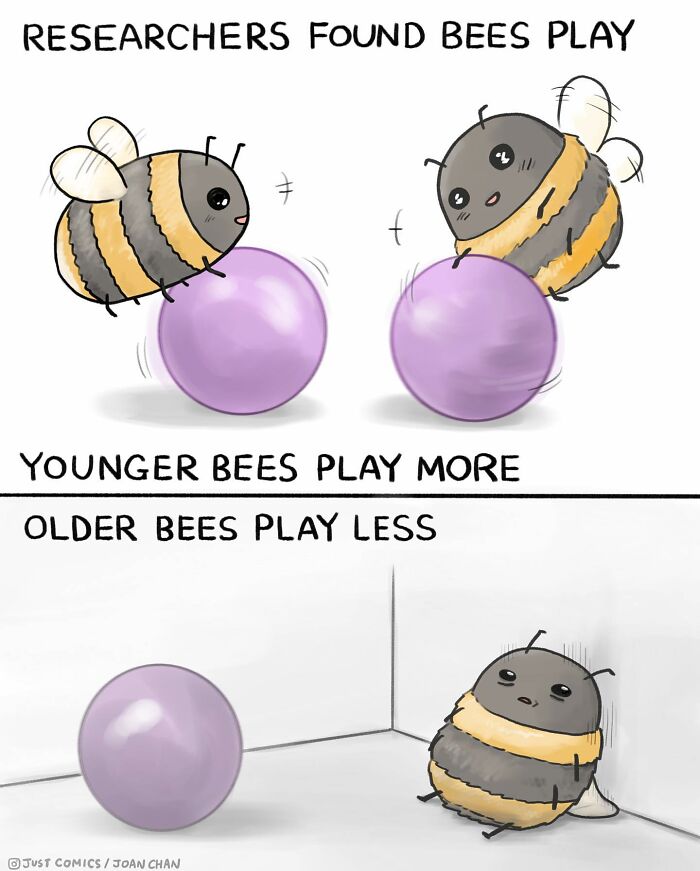
Image source: justcomics_official
#3
Seriously, I am so amused to know that there are fish who passed the mirror test! That is a “self-awareness” experiment that only a few animals like chimpanzees and dolphins have ever passed.
I thought I knew that fish are intelligent, but I still underestimated them. I didn’t expect such a tiny cleaner wrasse (only 10 cm long) proving themselves to have self-cognizance to use the mirror.
They help their clients (bigger fish) to clean off parasites. They have excellent observation skills and are highly social. (They need to serve different clients, have a complicated life…that is another story)
The study was published two years ago.
The fish shows aggressiveness the first time seeing the mirror. After they got used to it, the researchers placed a colored mark on their body. Then they just scape it off and check their reflection in the mirror again.
The study’s senior author, Australian scientist Alex Jordan said: “For a long time this test was a sort of gatekeeper to a special club of ‘smart animals’. This is silly, as not all animals will respond to the test in a way we can interpret. To then suggest these animals are stupid is misleading.”
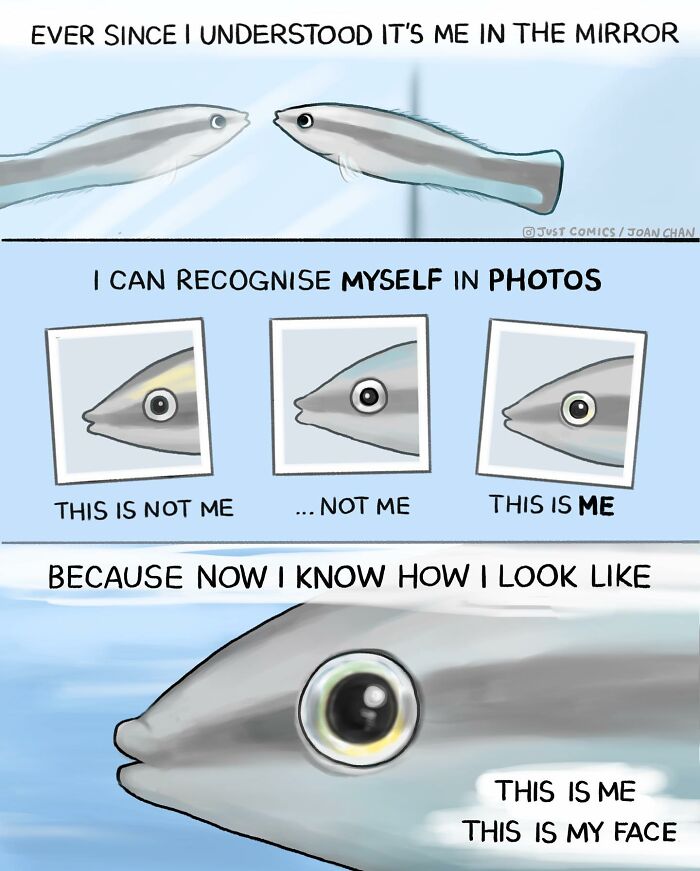
Image source: justcomics_official
#4
“Life Beyond a Jar,” a new study, finds that betta fishes get stressed and show more abnormal behaviors in small tanks.
The study rotated betta fishes between jars and tanks of different sizes, observing their behavior.
“In the jar and small tank, the fishes hovered more like they wanted to swim but just couldn’t get going, interacted with the walls more like they felt trapped and paced back and forth more, which is a known stress behaviour.” Dr. Naomi Clark-Shen explained in a PSA video. [2]
In larger tank (19 litres) the fishes swam more naturally with fewer stress behaviors. Even in bigger tanks they were stressed if the tank was empty, showing that plants and hiding spots are needed for them to feel safe and happy.
Fishes are the most common and numerous companion animals in the world. [3] In Thailand, over 20 million individual betta fishes were exported in 2018.🤯
The study calls for an end to the sale and housing in bags, cups, jars and small tanks.
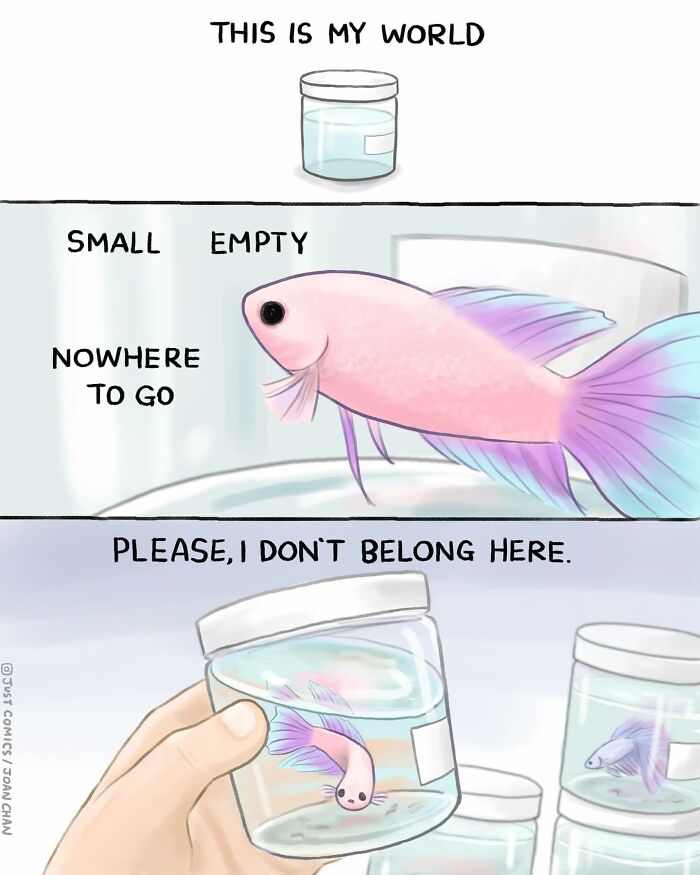
Image source: justcomics_official
#5
I drew this comic after I watched a video from Animal Australia about Prawn Eyestalk Ablation. The poor prawn’s eyeball was taken off like she is not a living being, her eyeball floating in the water in front of her.
Here is some info from @crustacean_compassion
“Eyestalk ablation is a widespread practice of removing one or both eyestalks of breeding female shrimp or prawns, often without anaesthetic, in order to increase egg production and reproductive success, since the eyestalk contains glands which regulate the ovaries. The practice is a violent solution to the fertility problems caused by captive conditions. It involves pinching the eyestalk off, slitting with a razor blade and then squeezing out the contents, cauterising it or ligating it.
Numerous scientists have found that the procedure appears to cause stress, trauma, and pain, with Australian vet Anthony Rowe describing it as:
‘practices that would defy the most fundamental animal welfare standards in vertebrates, yet is routinely practiced on invertebrates’. “
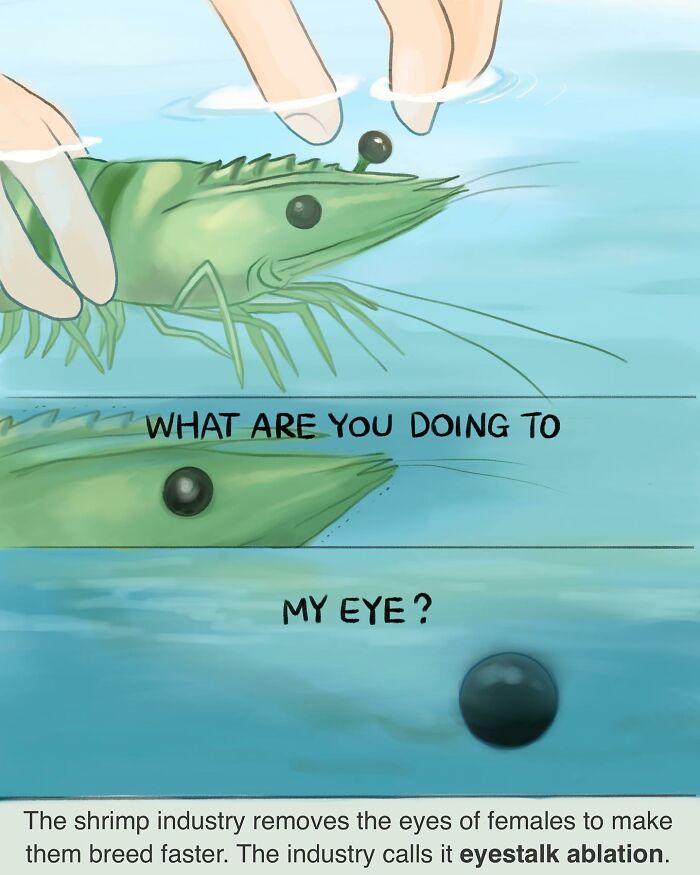
Image source: justcomics_official
#6
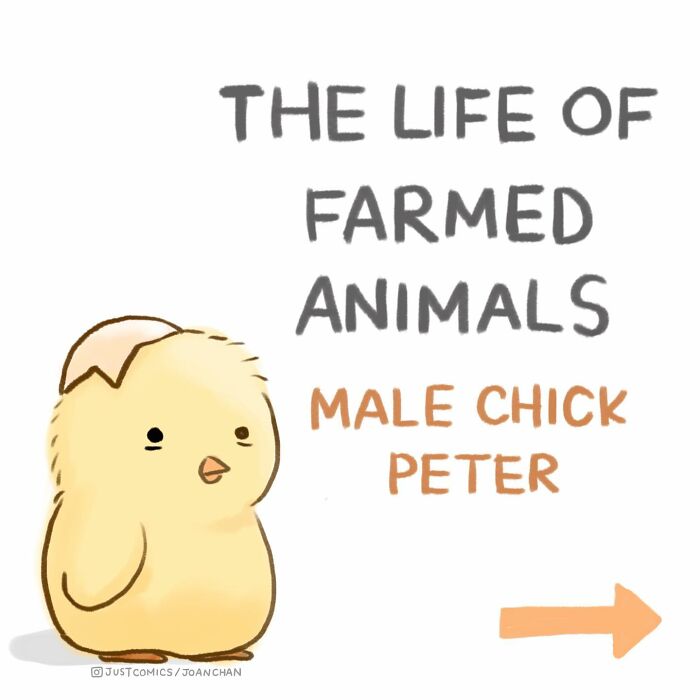
Image source: justcomics_official
#7
I drew this comic based on video footage of a calf trying to catch snowflakes with their tongue.
In the dairy industry, calves are confined in this kind of plastic hutches. Taken away from their mom, they can’t interact with others. Sometimes they are chained. Sometimes they need to face extreme weather, and investigations are revealing a pattern of neglect where calves suffer for days and freeze to death.
They will spend 2-3 months in this confinement by themselves. They can’t run, there is nothing to play or explore. They will never have the opportunity to follow their mom and friends around and get any affection.There is a strong bond between mother and calf.
In Chinese, there is an idiom “舐犢情深” (the cow licking her calf fondly) to describe a human’s deep love toward their children.
Cows are herd animals. They like hanging around together. There is research showing that early separation has long-term effects on the calves. Those growing up without parents and friends’ affection became less social, with more abnormal behavior and feel stress easier.
The hutches look like a graveyard, but it’s a graveyard for the living, for babies.
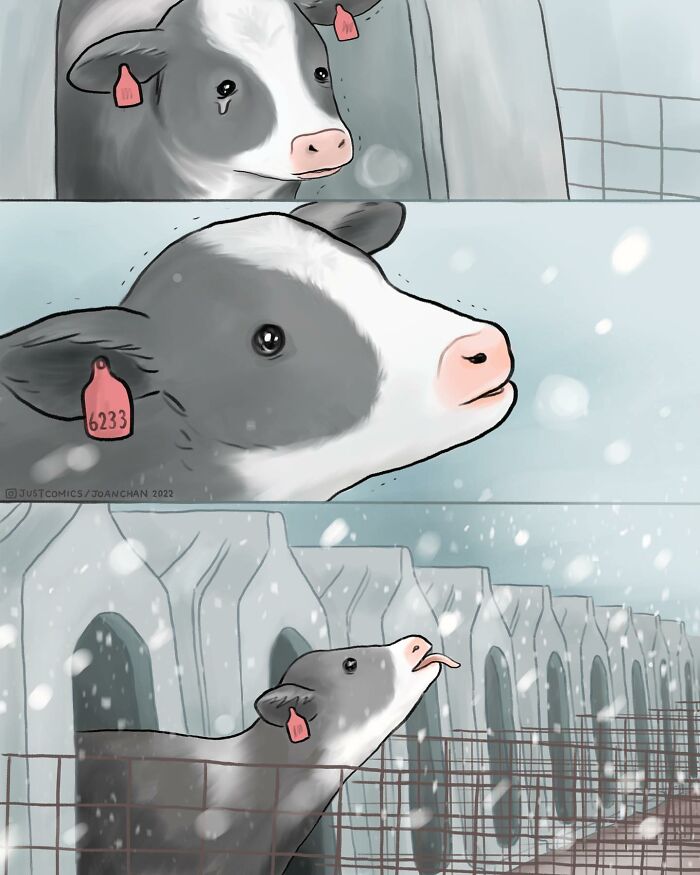
Image source: justcomics_official
#8
Many aquatic animals are being sold and transported alive during which they experience extreme stress.
If it were a mammal tied up, confined in boxes, squeezed in tight spaces, or stacked on top of each other, and at risk of suffocation, we would think it’s very cruel.
Lobsters are sentient beings, they can feel pain and anxiety. These fragile animals are going to suffer and panic from the vibration, pressure and swaying of traffic. It can cause bodily injuries. (sometimes they are being shipped internationally by air for 30 hours.) Some will die during the journey. (The industry calls it ‘shrink’)
Lobsters are very sensitive to temperature changes and they can sense subtle temperature differences probably as small as 0.15 °C. They prefer to stay in 15-18°C if they can choose their environment. However, sometimes they are put next to an ice gel pack.
Lobsters are just like us, they remember pain, and will choose to avoid pain [4]. If they are afraid, they will have the urge to seek a safe place to hide, which is impossible.
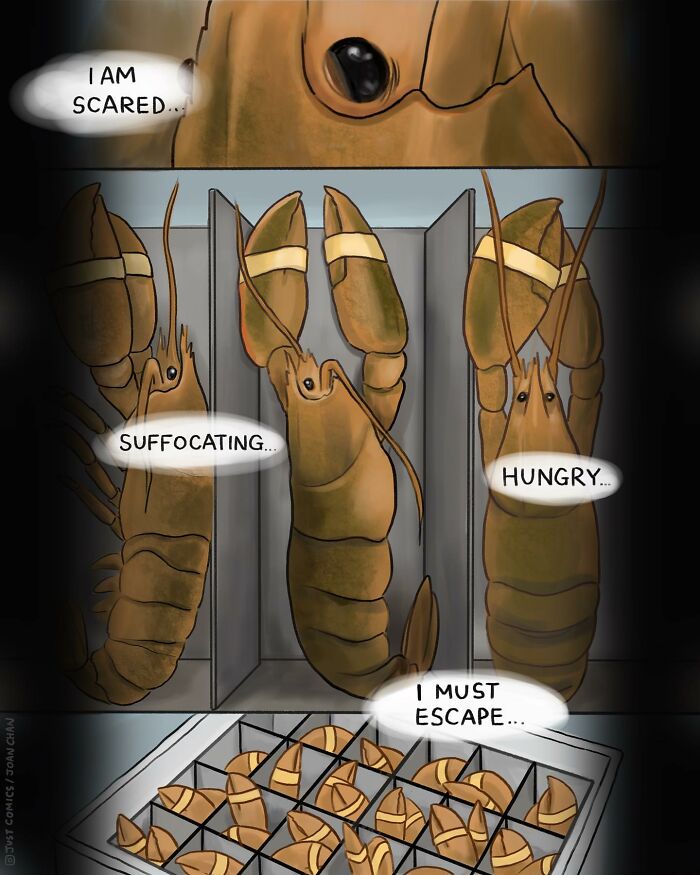
Image source: justcomics_official
#9
Chickens Blush When They Are Emotional
A recent study published in July discovered that chickens’ blushing reveals their emotions.
By recording and analyzing footage of chickens on a commercial farm in France, the team found that hens’ faces reddened according to their moods. Hens blushed slightly when they were excited, such as when rewarded with mealworms, and turned a deep scarlet when they were scared, such as upon hearing a warning signal or being grabbed by a human.
“Each one had their own quirks and personalities – some would startle very easily at the slightest noise, while others reacted much less,” researcher Aline Bertin said.
At the end of the study, researchers wrote: “The assumption of Darwin that blushing is ‘the most human of all expressions’ is seriously weakened by our results, which question the phylogenetic origin of emotional facial blushing in the animal kingdom.”
Blushing is not exclusive to humans, and animals have their own feelings and facial expressions too.
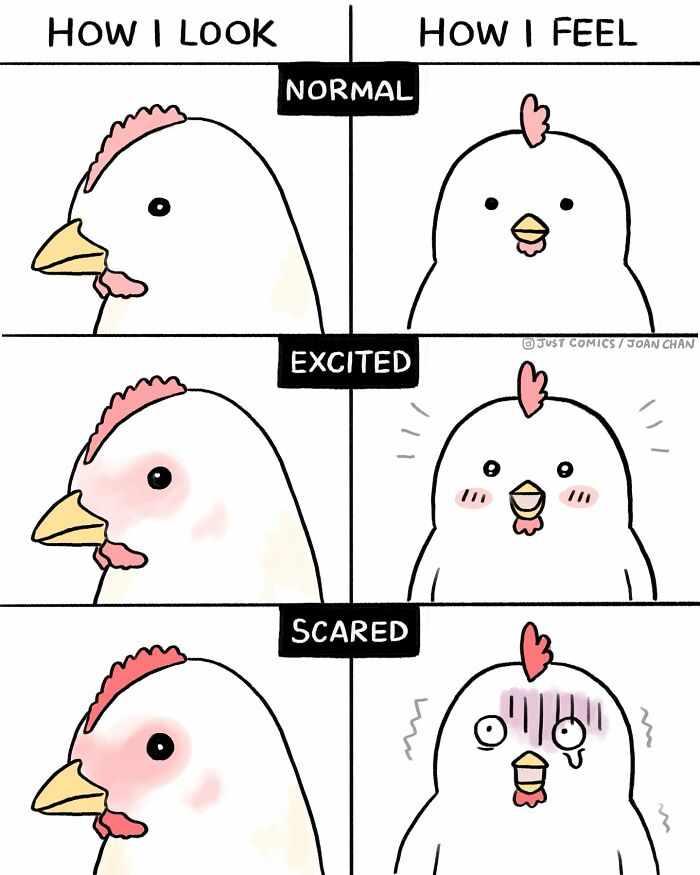
Image source: justcomics_official
#10
When I was 15 years old, after school I liked to buy chickens from the supermarket, because It was very cheap, just around 2 USD. At that time, I had never thought about the horrible price that animals pay for that.
My mom said when she was young, the chickens were all free-range.
Here in the Philippines, the chickens running wild are beautiful, they look shiny and full of energy, very alert and are curious about you.
There was one time we watched two chicks running around for 10 minutes playing “tag” with one holding a leaf in their mouth and another chasing.
This is not happening with fast-growing chickens in factory farms.
Chicks start developing their deformities as young as six days.
Those birds have been genetically manipulated to grow too big, too fast. Their bone, heart, and immune system fail to support their growth. Many of them have leg disorders.
They don’t move around much as it hurts to move, their legs can’t support their overgrown body. Sometimes they are unable to walk again and die from starvation.
Their bodies are designed by humans to only live for 42 days, when normally chickens can live for 5-12 years.
Animals pay a high price for our “cheap meat”.
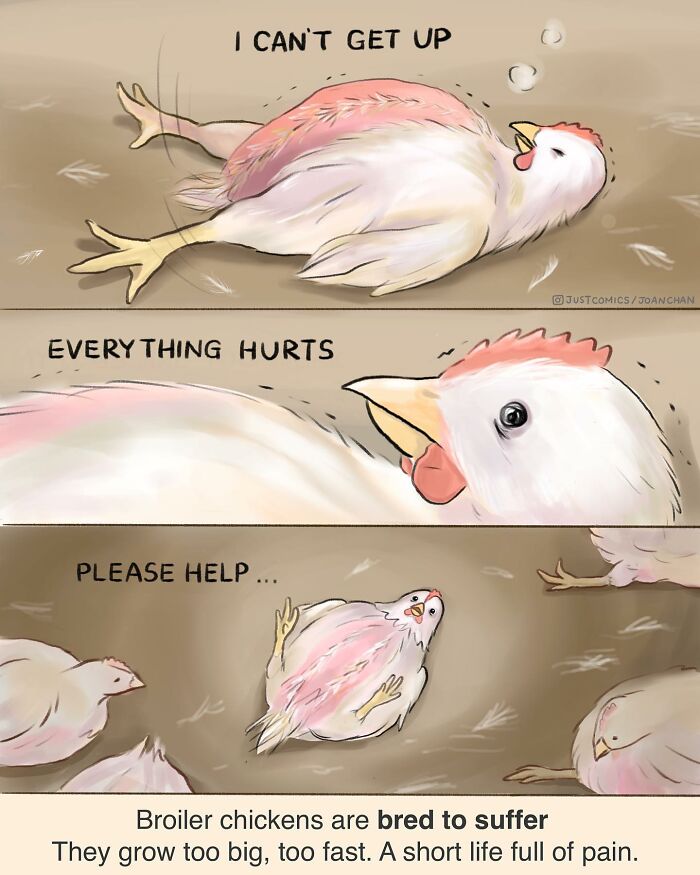
Image source: justcomics_official
#11
Fish can do math! 🐟I drew this story based on an recent study by the University of Bonn.
Cichlids and stingrays can add and subtract ‘one’ in the number space from one to five.
Blue means “add one,” yellow means “subtract one”
After the fish understood the rules behind the colors, they were shown two gates with cards containing either blue or yellow shapes, one gate being the correct answer with a reward behind it.
“They had to memorise what they had seen previously, and they had to add and subtract exactly one,” says Professor Vera Schluessel who led the research.
“It’s quite surprising to see what abilities these types of animals actually have when we give them a chance. Many people protest against putting cows or chicken into tiny cages, but very few people go on the street for fish,”
“Accordingly, they are quite far down in our favor—and of little concern when dying in the brutal practices of the commercial fishing industry,” says Schluessel.
We always underestimate fish. Are you also surprised by how amazing they are?
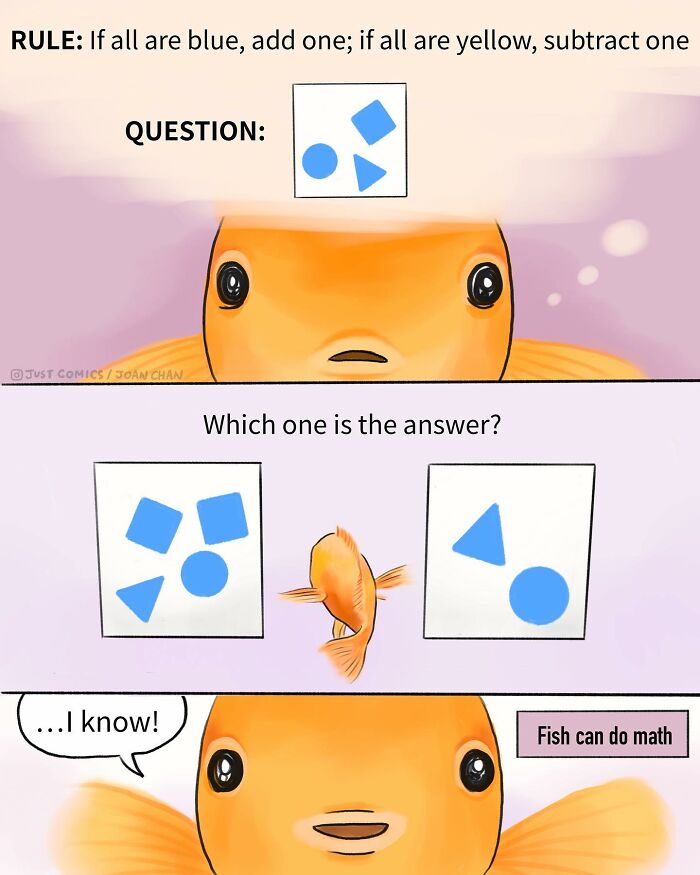
Image source: justcomics_official
#12
3 cm fish have preferences too!
Studies have found that given a choice of two compartments, zebrafishes consistently avoid barren tanks, preferring to stay in tanks with gravel, plants, or even just images of gravel!
A more resourced living environment may also help lower their anxiety, reduce stress responses, and improve their ability to cope with pain.
Researchers hypothesize that “the stress-blunting effect of environmental enrichment occurs by providing fish a sense of safety or security in a natural environment with refuge alternatives.” Barren tanks with no places to hide leave them feeling more vulnerable and more reactive to stress—they remain in an alert state.
Zebrafishes are one of the most frequently used animals in laboratories, with an estimated 5 million worldwide. Many of them live in barren tanks, devoid of any form of “enrichment”.
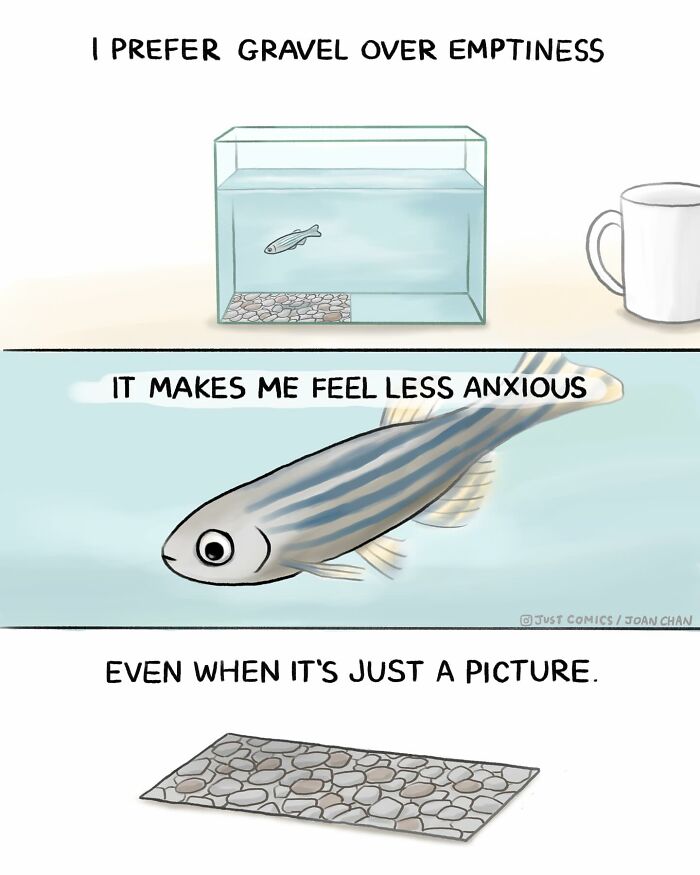
Image source: justcomics_official
#13
I used to enjoy encountering new cat friends on the street, but after many experiences, my feelings have become very complicated, especially after that night.
It was my first time seeing a cat in my condo building (our condo doesn’t allow animals). We were so excited to see a cute visitor from the neighborhood. She had a collar, we thought she was just wandering and had gotten a bit lost. But then, the next day, I noticed the once noisy tiny bird nest hidden in the bush outside my door was silent…and since then, I have never heard any noise again…I hope the baby birds just moved to another place and it was just a coincidence…
Cats are born hunters, outdoor cats kill 640 million birds and mammals in the U.S. and Canada combined each year. [1] Keeping cats indoors is not only good for wildlife but also good for the cats. Outdoor cats have a shorter lifespan due to parasites, cat fights, etc., and road trauma is the leading cause of death for cats under 5 years old.
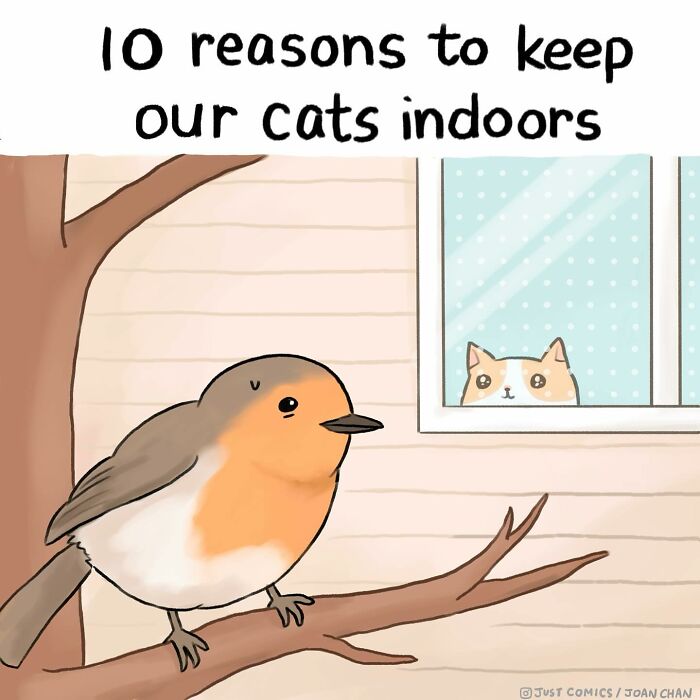
Image source: justcomics_official
#14
Fishes learn—and they learn from each other.
We often think that fish migration is purely instinct—but for some species, it also depends on learning and memory.
Long-lived, social fishes like cod rely on social learning to navigate migrations and reach their spawning and feeding grounds.
This knowledge isn’t written in their DNA. It’s passed from generation to generation, as younger fishes learn from their elders.
According to a 2025 study in Fish & Fisheries, losing socially learned knowledge in long-lived fish may lead to the collapse of local populations.
In Eastern Maine, following the collapse of the cod population in the 1990s, long-term surveys have since caught only juveniles. This year—35 years later—the first adult cod was recorded.
We thought that if we took away the big fishes and left the little ones behind, they would grow up and carry on their kind. But what we took wasn’t just lives—we erased the accumulated adaptive knowledge that had guided their survival. Once it’s gone, it can’t be recovered.

Image source: justcomics_official
#15
Fish can do math!
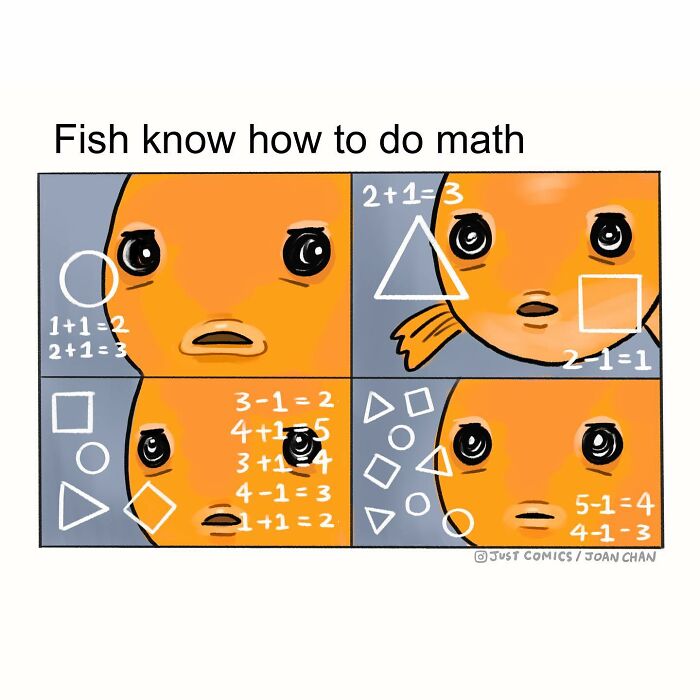
Image source: justcomics_official
 Follow Us
Follow Us





